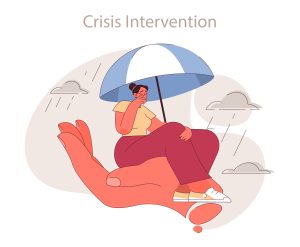29 Crisis Intervention Theories and Intervention and Treatment Approaches
Alexandria Lewis

Content Outline, Competency, and KSAs
I. Human Development, Diversity, and Behavior in the Environment
1A. Human Growth and Development
KSAs:
– Crisis intervention theories
III. Interventions with Clients/Client Systems
IIIA. Intervention processes and techniques for use across systems
KSA:
– Crisis intervention and treatment approaches
overview
A crisis can be defined as a critical event or period of significant change, which is perceived as a threat to an individual’s or group’s usual coping mechanisms, potentially causing psychological stress or emotional instability. This situation often requires urgent and immediate intervention. Crises can vary widely in their nature and impact, including personal events such as the loss of a loved one, job loss, or serious health diagnoses, as well as larger-scale events like natural disasters, acts of terrorism, or community violence. The key elements that characterize a crisis include:
- A Triggering Event: A specific incident or accumulation of events that disrupt the equilibrium of the individual or group, leading to a state of instability.
- Perceived Threat: The individual or group perceives the event as a significant threat to their wellbeing, which overwhelms their usual coping strategies and resources.
- High Levels of Stress and Distress: The crisis induces high levels of psychological stress and emotional distress, which can manifest in various ways, including anxiety, depression, confusion, or anger.
Crisis intervention addresses the urgent needs of individuals, groups, families, and communities facing acute stressors that challenge their capacity to cope.
Crisis intervention is defined as:
- “the brief ameliorative, rather than specifically curative, use of psychotherapy or counseling to aid individuals, families, and groups who have undergone a highly disruptive experience, such as an unexpected bereavement or a disaster. Crisis intervention may prevent more serious consequences of the experience, such as posttraumatic stress disorder…psychological intervention provided on a short-term, emergency basis for individuals experiencing mental health crises” (Source: APA Dictionary of Psychology).
crisis intervention theories
Crisis intervention theories help in recognizing the signs of crisis, assessing the client’s mental and emotional state, and determining the most effective strategies for intervention.
There are several models for individual crisis intervention, such as Roberts seven-stage crisis intervention model (Eaton-Stull, 2015):
- Plan and conduct a crisis assessment: This initial stage involves gathering information to understand the nature of the crisis.
- Rapid establishment of rapport: Concurrent with the assessment, establishing a connection with the client is essential for effective intervention. This rapport builds trust.
- Identify major problems: Through dialogue and assessment, the social worker and client collaborate to identify the key issues contributing to the crisis. This stage focuses on distinguishing between the client’s perceived problems and the actual problems.
- Explore feelings and emotions: This stage allows the client to express their feelings and thoughts related to the crisis, providing the social worker a deeper insight into the client’s emotional state and potential triggers.
- Generate and explore alternatives: Together, the client and social worker brainstorm potential solutions and coping strategies. This collaborative problem-solving approach empowers the client, promoting resilience and self-efficacy.
- Develop an action plan: Based on the alternatives discussed, an actionable and practical plan is formulated to address the crisis. This plan includes short-term goals to alleviate the immediate crisis and longer-term strategies for resilience and recovery.
- Follow-up: This final stage involves checking in with the client after the initial intervention to assess their progress, make necessary adjustments to the action plan, and provide additional support. Follow-up is crucial for ensuring the client’s return to pre-crisis functioning or better.
Another example of a crisis intervention model is James and Gilliland’s six step crisis intervention model (Cavaiola & Colford, 2018):
- Defining the problem
- Ensuring client safety
- Providing support
- Examining alternatives
- Making plans
- Obtaining commitment
Both the model by James and Gilliland and Roberts’ model share common ground in their foundational steps, including crisis assessment, establishing contact with the person in crisis, exploring resolution alternatives, and committing to a plan of action.
Major concepts (Walsh, 2014):
- Crisis (developmental, situational, existential)
- Stress
- Crisis response (growth, equilibrium)
- Coping and adaptation
- Problem-focused coping
- Emotion (affective)-focused coping
- Social support
Crisis Intervention and Treatment Approaches
Crisis intervention and treatment approaches are considered brief interventions with a focus of managing stress with a goal of equilibrium (state of balance/stability). There are several critical elements to consider in crisis intervention and treatment approaches:
- Immediate response
- Safety first (assessment of risk)
- Build rapport
- Crisis context (seek to understand the client’s perception of the crisis, including cultural, social, and personal factors that influence their experience and response)
- Focus on strengths and empowerment
- Collaborative problem-solving
- Cultural sensitivity
- Flexibility (adapt intervention strategies to fit the unique needs of each situation and individual)
- Follow-up and continuity of care
Intervention goal:
- Enhance coping skills, and return the client to their level of functioning before the crisis occurred.
self-check
References
Cavaiola, A.A., & Colford, J.E. (2018). Crisis intervention: A practical guide. SAGE Publications, Inc.
Eaton-Stull, Y. (2015). Crisis intervention with individuals and groups: Frameworks to guide social workers. In K. Corcoran & A. R. Roberts (Eds.), Social workers’ desk reference (pp. 217-223). Oxford.
Walsh, J. (2014). Theories for direct social work practice (3rd ed.). Cengage Learning, Inc.

